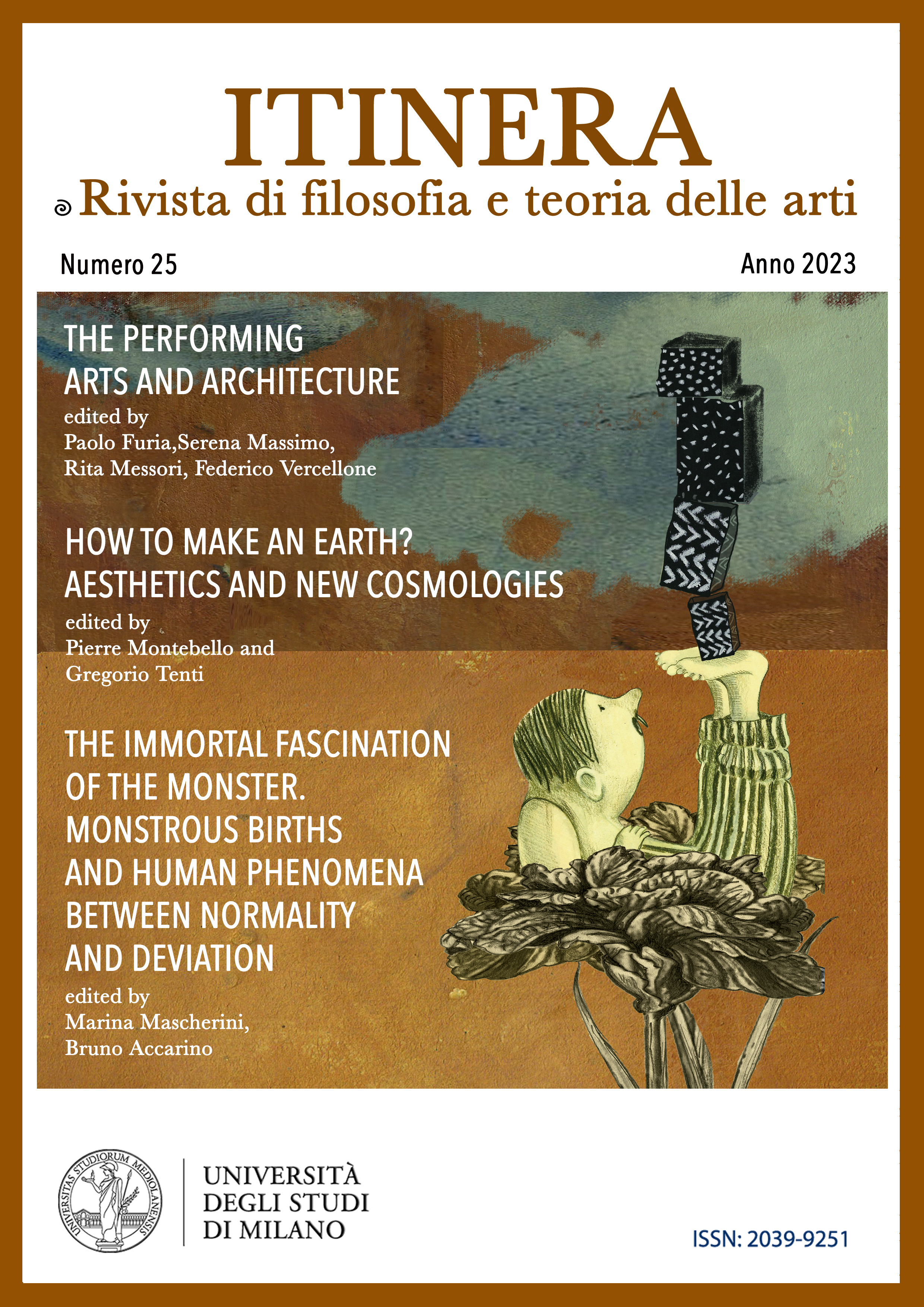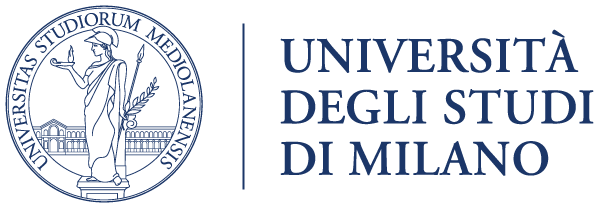Performativity and Aesthetic Experience of the City. From the body of the flâneur to the soma of the Man in Gold.
DOI:
https://doi.org/10.54103/2039-9251/20808Parole chiave:
Body, Soma, Aesthetic Experience, CityAbstract
In this essay, I do not want to focus on performativity as such and understand it as an aesthetic expression; instead, I would like to illustrate how performativity takes on the role consequential to an aesthetic experience. Specifically, I want to highlight how aesthetic experience takes place in the spatial contexts of the city. In this regard, I want to define the aesthetic-practical-sensory relationship of the soma, understood as a paradigm of a living body, that is, a body that moves and acts in space, by declining three historical moments that tell the story. I want to define three historical moments from the early twentieth century to the present through the soma-city relationship: 1) The first moment is inscribed in the emergence of the Baudelairian concept of the flâneur, a symbolic figure who introduces a relationship with the city characterized by a disenchanted gaze and a slow, wandering movement picked up, especially by Walter Benjamin in the Paris Passages; 2) The second moment is that of Situationism, in which Guy Debord introduces the concept of dérive, understood as an approach to the city marked by the experiential and emotional relationship; 3) The third and most recent moment concerns Richard Shusterman's embodiment of the somaesthetic exercise, in which the Avatar of the Man in Gold, enters into a relationship with the city, aspiring to reconnect urban spheres and not to a pure somaesthetic experience of the city. The last point to be made is that these three historical and aesthetic experience-based moments of the body in the city are marked by the body moving in space. In the case of the flâneur, the body wanders in an unresolved manner without a precise destination; in the case of the drift, the body is propelled by the many sensations and expressions of the city that are expressed through walking (urban Walkscapes); finally, in the case of the Man in Gold, there is a movement totally absorbed in the experience of places.
Riferimenti bibliografici
Alison, A., Can an Extra-terrestrial Dwell on Earth?, in “ESPES – The Slovak Journal of Aesthetics, V.11, n°2, 2022, pp. 54 – 68, https://espes.ff.unipo.sk/index.php/ESPES/article/view/270 , Last consultation 24.05.2023.
Baudelaire, C., The Painter of Modern Life and Other Essays, Phaidon Press, New York, 1995.
Baumgarten, A. G., Ästhetik (1750–58), Eng. Trans. By D. Mirbach, Volume 1: Latin - German. Felix, Meiner Verlag, Hamburg, 2007.
Benjamin, W., The Arcades Project, Eng. Trans. By H. Eiland, K. McLaughlin, Harvard University Press, Harvard, 2002.
Careri, F., Walkscapes: camminare come pratica estetica, Einaudi, Torino, 2006.
Careri, F., Walkscapes El andar como práctica estética. Walking as an aesthetic practice, Editoria Gustavo Gill, Barcelona, 2009.
Careri, F., Walkscapes: walking as an aesthetic practice, Culicidae Architectural Press, Ame, 2017.
Holl, S., Pallasmaa, J., Perez-Gomez, A., (eds.), Questions of Perception: Phenomenology of Architecture, A+U Architecture and Urbanism, Tokyo, 1994.
Merleau-Ponty, M., The Phenomenology of Perception (1945), Eng. Trans. By C. Smith, Routledge, London, 2005.
Preciado, P. B., An apartment on Uranus. Chronicles of the Crossing, Semiotext(e), Los Angeles, 2020.
Shusterman, R., Urban Scenes and Unseens, in “Filozofski vestnik”, Vol. 17, n°2, (1996): The Seen, pp. 171 -179, Last consultation: 21.05.2023.
Shusterman, R., Somaesthetics a disciplinary proposal, in “The Journal of Aesthetics and Art Criticism”, Vol.57, n°3, (Summer 1999), pp. 299 - 313, https://academic.oup.com/jaac/article/57/3/299/6342209 , Last consultation 22.05.2023.
Shusterman, R., The Silent, Limping Body of Philosophy, in T. Carman & M. Hansen (Eds.), The Cambridge Companion to Merleau-Ponty, Cambridge, Cambridge University Press, 2004.
DOI :10.1017/CCOL0521809894.007, pp. 151 – 180.
Shusterman, R., The Silent, Limping Body of Philosophy, in Body Consciousness. A Philosophy of Mindfulness and Somaesthetics, Cambridge University Press, 2012.
Shusterman, R., Toma, Y., The adventures of the man in gold. Paths between art and life. A philosophical tale. Les aventures de l’homme en or. Passages entre l’art et la vie. Conte philosophique, Hermann, Paris, 2016.
Shusterman, R., Bodies in the Streets: The Soma, the City, and the Art of Living, in Bodies in the Streets and the Somaesthetics of City Life, in “Studies in Somaesthetics. Embodied Perspectives in Philosophy, the arts and the human sciences”, Vol.2, 2019, pp. 13 – 37.
Shusterman, R., Merleau-Ponty’s Somaesthetics, in “Critique d’art” [Online], 37 | Printemps 2011, Online since 14 February 2012, connection on 08 August 2021, Last consultation: 22.05.2023.
URL: http://journals.openedition.org/critiquedart/1300;
DOI: https://doi.org/10.4000/critiquedart.1300
Shusterman, R., Pragmatist Aesthetics and Critical Theory: A Personal Perspective on a Continuing Dialogue, in “Scenari”, n°16, 2022, pp. 197 – 217, Last consultation 23.05.2023.
Simmel, G., The Metropolis and the Mental Life (1903), adapted by D. Weinstein from Kurt Wolff (Trans.), The Sociology of Georg Simmel, Free Press, New York, 1950, p.410.
Situationist International Anthology, Ed. & Trans. By K. Knabb, Berkley, Bureau of Publict Secrets, 2006.
Sitology
https://www.spatialagency.net/database/stalkerosservatorio.nomade
Dowloads
Pubblicato
Versioni
- 2023-12-29 (2)
- 2023-08-08 (1)
Fascicolo
Sezione
Licenza
Copyright (c) 2023 Aurosa Alison

Questo lavoro è fornito con la licenza Creative Commons Attribuzione - Condividi allo stesso modo 4.0.
Gli autori che pubblicano su questa rivista accettano le seguenti condizioni:
1. Gli autori mantengono i diritti sulla loro opera e cedono alla rivista il diritto di prima pubblicazione dell'opera, contemporaneamente licenziata sotto una Licenza Creative Commons - Attribuzione - Condividi allo stesso modo 4.0 internazionale che permette ad altri di condividere l'opera indicando la paternità intellettuale e la prima pubblicazione su questa rivista.
2. Gli autori possono aderire ad altri accordi di licenza non esclusiva per la distribuzione della versione dell'opera pubblicata (es. depositarla in un archivio istituzionale o pubblicarla in una monografia), a patto di indicare che la prima pubblicazione è avvenuta su questa rivista.
3. Gli autori possono diffondere la loro opera online (es. in repository istituzionali o nel loro sito web) prima e durante il processo di submission, poiché può portare a scambi produttivi e aumentare le citazioni dell'opera pubblicata (Vedi The Effect of Open Access).





